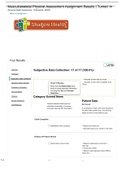Exam (elaborations)
NR509 Week 5 quiz/88 Questions And Answers/100% Correct 2024
- Course
- , NR509,
- Institution
- Chamberlain College Of Nursing
NR509 Week 5 quiz/88 Questions And Answers/100% Correct The nurse educator is preparing an education module for the nursing staff on the epidermal layer of skin. Which of these statements would be included in the module? The epidermis is: a. Highly vascular. b. Thick and tough. c... Thin and ...
[Show more]












